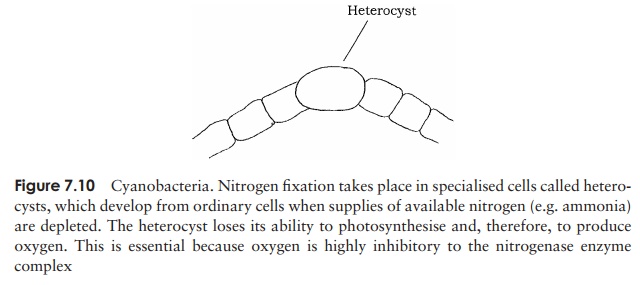Chapter: Essential Microbiology: Procaryote Diversity
Phylum Cyanobacteria: the blue-green bacteria
Phylum
Cyanobacteria: the blue-green bacteria
The Cyanobacteria are placed in volume 1 of the
second edition of Bergey, along with
the Archaea , the deeply branching bacteria, the ‘Deinococcus–Thermus’ group,
and the green sulphur and green non-sulphur bacteria.
Members of the Cyanobacteria were once known as
blue-green algae because they carry out the same kind of oxygenic photosynthesis as algae and green plants). They are the
only group of procaryotes capable of carrying out this form of photosynthesis;
all the other groups of photosynthetic bacteria to be discussed carry out an
anoxygenic form. When it became possible to examine cell struc-ture in more
detail with the electron microscope, it became clear that the cyanobacteria
were in fact procaryotic, and hence quite distinct from the true algae. Old
habits die hard, however, and the term ‘blue-green algae’ is still encountered,
particularly in the popular press. Being procaryotic, cyanobacteria do not
possess chloroplasts; however they contain lamellar membranes called thylakoids, which serve as the site of
photo-synthetic pigments and as the location for both light-gathering and
electron transfer processes.
Early members of the Cyanobacteria evolved when the
oxygen content of the earth’s atmosphere was much lower than it is now, and
these organisms are thought to have been responsible for its gradual increase,
since photosynthetic eucaryotes did not arise until many millions of years
later.
Cyanobacteria are Gram-negative bacteria which may be
unicellular or filamentous; in spite of the name by which they were formerly
known, they may also appear vari-ously as red, black or purple, according to
the pigments they possess. A characteristic of many cyanobacteria is the
ability to fix atmospheric nitrogen, that is, to reduce it to ammonium ions (NH4+ ) for
incorporation into cellular constituents. In filamentous forms, this activity
is associated with specialised, enlarged cells called heterocysts (Figure 7.10).

The tiny unicellular cyanobacterium Prochlorococcus is found in oceans
throughout the tropical and temperate regions and is thought to be the most
abundant photosyn-thetic organism on our planet. It has several strains adapted
to different light conditions. Some cyanobacteria are responsible for the
production of unsightly (and smelly!) ‘algal’ blooms in waters rich in
nutrients such as phosphate. When they die, their decomposition by other
bacteria leads to oxygen depletion and the death of other aquatic life forms.
Bloom-forming species contain gas vacuoles to aid their buoyancy.
Representative genera: Oscillatoria, Anabaena
Related Topics